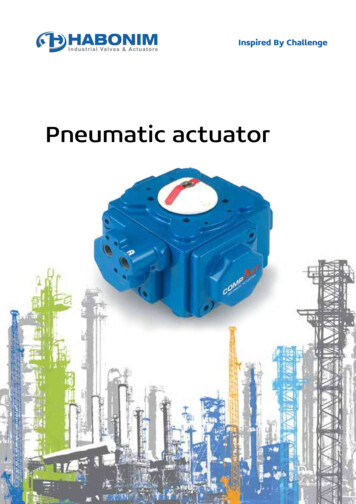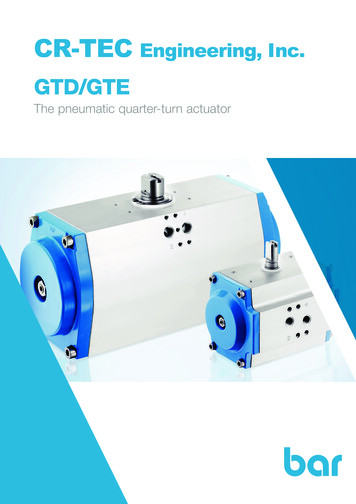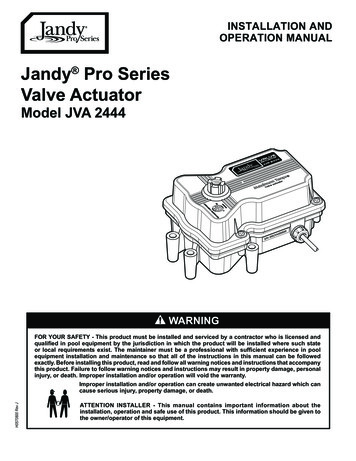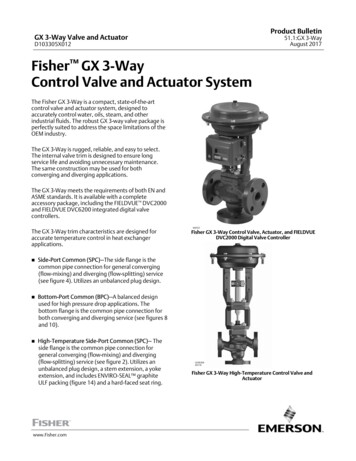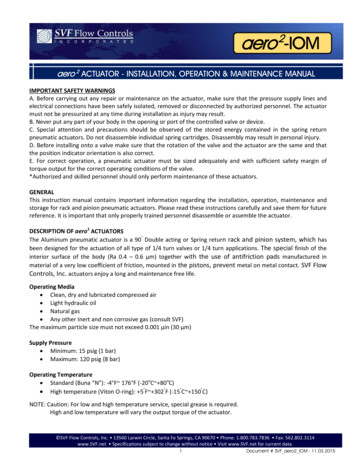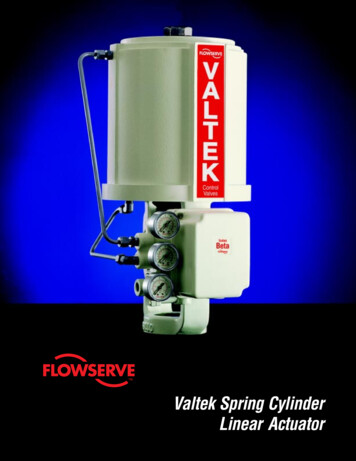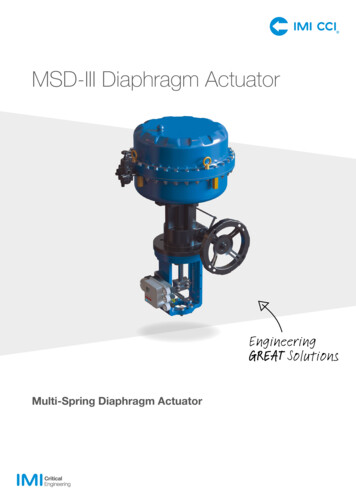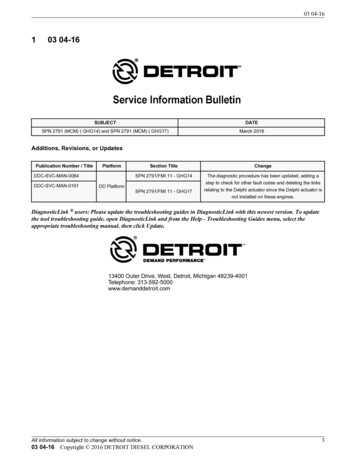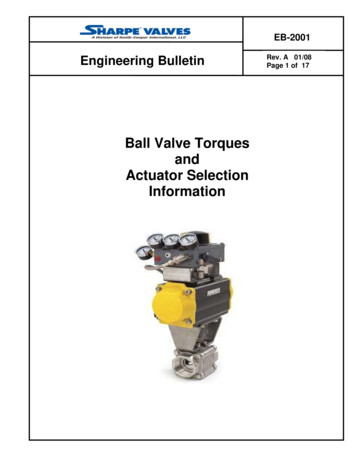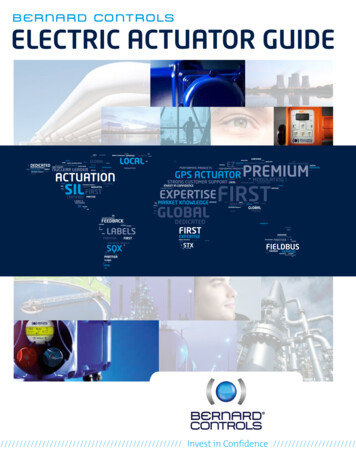
Transcription
B E RNA RD CONT ROLSELECTRIC ACTUATOR GUIDEInvest in Confidence
2Solutions always by your side2 labels: total solutions for your applicationsThe automation of industrial machinery and equipment addresses human and financialchallenges of security and productivity.Our leadership in the nuclear market with more than 120 reactors installed worldwide and ourcontinuous experience from the 70’s have shaped our expertise and our control of processes.Our understanding of industrial processes drives the design and manufacturing of our electricalactuators. Our vision of controls furthers the appearance of solutions fully adapted to markets’evolutions and to our customers’ budgetary and technological requirements.That is why our electromechanical profile has developed into an expertise in the management ofevermore complex systems.BERNARD CONTROLS propose 2 labels which federate well different ranges of actuator solutions:SIMPLE, STURDY, ECONOMICALIn order to fulfill the need for actuatorsthat are both simple and sturdy, we havecreated the FIRST BC label.This label guarantees quality and security toinstallations’ electric actuation solutions in thecase of moderate environmentaland operational constraints.DEDICATED SOLUTIONSTo fulfill the need for reliable, highperformance and innovative actuators,we have defined the BC PREMIUM label.The BC PREMIUM label is the guarantee ofquality and security for installations’ actuationin the case of demanding environmentaland operational constraints.ContentsSolution always by your sideInnovation always by your sideA dedicated guide to define yourmodel of actuatorFocus on Operation 23 46Range Overview withDuty and Modulating Classification Focus onBC Technologies & Services Specifications 141618
3Innovation always by your sideGPS ActuatorT he best way to find your electric actuation solutionGPS Actuator is the web application developed byBERNARD CONTROLS that helps you find your way to yourelectric actuation solution.As suggested by its name, the GPS function of this applicationsimply drives you to the best solution to your needs, following 5key steps.www.gpsactuator.comFlash this QR code and access BC GPS Actuator!IA IIIII Specification Guide
4A dedicated Guideto define your model of actuatorUsing the GPS actuator, you will end up with a range of BERNARD CONTROLS’electric actuators.This Guide continues the selection process and helps you to finalize your requesttaking into account all parameters and options.Review each step of the GPS Actuator selection with comments on the right page. Then, read throughdata and additional explanations on next pages and fill in the detachable specification sheet at the end ofthe document.You will be sure to consider all criteria to select the appropriate actuation solution.At any time, BERNARD CONTROLS teams are available for support.From basic quotation to specific design or project design, do not hesitate to contact our sales teams. Theycan help you to fill in the form and inform about only options or technologies.
5Movement to operate the valvePart-turnMulti-turnLinear Movement selection has to be completed with data about your valve to ensure good fitting of the actuator to your valve.EnvironmentInside a buildingOutdoor undera shelterOutdoorRisk of temporary ear site Location and working environment impose to specify watertightness level, enclosure MODULATINGCONTINUOUSMODULATINGA BB IIIIII IIII I BC GPC Actuator presents Duty and Modulating Classification. More information on pages 6 to 15.SecuritySTAYPUTSAFEPOSITIONControl Choice of controls has to be completedwith options, security requirement, electricconnections, signaling information .Additional options and information to be selectedon the specification sheet at the end.Specification Guide
6Focus on OperationActuator Duty & Modulating ClassificationOperation is a decisive step in your electric actuator selection.Looking carefully at your process requirement will make the difference.Actuator DutyThe EN 15714-2 Standard defines 4 actuator duties with basic design requirements per movement tooperate the valve: part-turn, multi-turn and linear.Class AClass BClass CClass DOn-OffInching / PositioningModulatingContinuous modulatingThe actuator is required todrive the valve through itsentire travel from thefully open position tothe fully closed positionor vice-versa.The actuator is requiredto occasionally drivethe valve to anyposition.The actuator is requiredto frequently drive thevalve to any positionbetween fully open andfully closed.The actuator is requiredto continuously drivethe valve to any positionbetween fully open andfully closed.Relying on its experience and on years of customers’ feedbacks, BERNARD CONTROLS considers thatthese 4 types of operation must be specified with key criteria in order to define theunique appropriate solution to the process requirement of each customer. On-Off & Positioning: Increase ENDURANCEConsidering On-Off applications (Class A) and Inching/Positioning applications (Class B), processrequirements imply to set ENDURANCE as the decisive criteria. Number of cycles, i.e. life time of theactuator, will make the difference for the customer and his application. Modulating & Continuous Modulating: Improve PERFORMANCEModulating and Continuous Modulating applications require specific expertise to define the mostappropriate solution. For many years BERNARD CONTROLS has been a leader in electric actuation and aforerunner in modulating technology. Our modulating classification (Class III which complies with EN15714-2Modulating and Classes II & I which comply with EN15714-2 Continuous modulating) is now well-knownfrom our customers and has, in fact, inspired the EN 15714-2 Standard.Duty PERFORMANCE is the main criterion to fully address modulating process requirements, but needs tobe specified and completed with additional performance criteria.BERNARD CONTROLS sets 4 additional performance criteria to EN15714-2 basic design requirements:RESOLUTION *Response Time*Dead BandThese criteria determine the efficiency of the modulating process.*Linearity*
7STANDARD DUTY CLASSIFICATIONENDURANCE ODULATINGAA BB IIIIII IIII IBC RESPONSE TO MARKETS NEEDS:BC offers products for On-Off Class A& Inching/Positioning Class B.BC also proposes products with longerlifetime / increased ENDURANCE : A & B .PERFORMANCE ( RESOLUTION,Dead band,Response Time,Linearity)BC RESPONSE TO MARKETS NEEDS:BC completes its modulating classificationand defines a new segmentation.BC offers Class III & Class II products andalso has a clear definition of solutions formore demanding modulating performances( Classes III / II / I )BC DUTY & MODULATING CLASSIFICATIONFind detailed data per movement and classes on next pages and BERNARD CONTROLS product offer with availableclasses on pages 14 & 15.DEFINITIONS * RESOLUTION: the smallest achieveable step at the output shaft of the electric actuator. DEAD BAND: the range through which an input signal may vary, upon reversal of direction, without triggering any observable change in theposition of the valve. REPONSE TIME: the time needed by the actuator to reach position following an input signal change. LINEARITY: the percentage of change in input signal must approximate the percentage of the change at the output of the actuator.Specification Guide
8Part - Turn ActuatorClass BClass AInching / PositioningActuator dutySTANDARD CLASSIFICATIONOn - OffEN 15714 - 2ON - OFFStandard Duty Class AStandard Duty Class BEndurance (1)number ofcyclesDutyPerformancecycles per hourTorqueNm1510 000 126126 - 1 000Endurance (1)number ofcyclesDutyPerformancestarts per hourTorqueNm 12612010 0001010 000126 - 1 0006010 0001 001 - 4 00055 0001 001 - 4 000305 0004 001 - 32 00052 5004 001 - 32 000152 500 32 00051 000 32 00051 000(1) Endurance Test Requirement Standard EN 15714 - 2ENDURANCE CRITERIAProcess RequirementsBC DUTY & MODULATING CLASSIFICATIONEN 15714 - 2INCHING / POSITIONING(1) Endurance Test Requirement Standard EN 15714 - 2ENDURANCE CRITERIAABON - OFFINCHING / POSITIONINGEndurance Class AEndurance Class BTorqueNmDutyPerformancecycles per hourEndurance (1)number ofcyclesTorqueNmDutyPerformancestarts per hourEndurance (1)number ofcycles 1261510 000 12612010 000126 - 1 0001010 000126 - 1 0006010 0001 001 - 4 00055 0001 001 - 4 000305 0004 001 - 32 00052 5004 001 - 32 000152 500 32 00051 00051 000(1) Endurance Test Requirement Standard EN 15714 - 2 32 000(1) Endurance Test Requirement Standard EN 15714 - 2A B ON - OFFINCHING / POSITIONINGEndurance Class A TorqueNmEndurance Class B DutyPerformancecycles per hour(2)Endurancenumber ofcyclesTorqueNmDutyPerformancestarts per hourEndurance (2)number ofcycles 12615100 000120100 000126 - 1 0001030 000126 - 1 0006030 0001 001 - 4 000510 0001 001 - 4 0003010 0004 001 - 32 00055 0004 001 - 32 000155 000 32 00052 000 32 00052 000(2) Endurance Higher Level than Standard EN 15714 - 2DEFINITIONS 126(2) Endurance Higher Level than Standard EN 15714 - 2 Torque is based on EN ISO 5211 One cycle consists of nominal 90 angular travel in both directions (i.e. 90 to open 90 to close), based on an average loadof at least 30 % of the rated torque with the ability to transmit 100 % of the rated torque for at least 5 % at each end oftravel. For angular travel other than 90 , the endurance shall be agreed between the purchaser and the manufacturer/supplier. One start consists of a movement of at least 1 % in either direction, with a load of at least 30 % of the rated torque. TBA: To be agreed between manufacturer / supplier and purchaser.
9Design requirements per classesClass CClass DModulatingContinuous ModulatingEN 15714 - 2MODULATINGCONTINUOUS MODULATINGStandard Duty Class CDuty (1)Performancestarts per hourTorqueNm 126EN 15714 - 2Standard Duty Class DEndurancenumber ofstartsDuty (1)Performancestarts per hourTorqueNmEndurancenumber ofstarts1 2001 800 000 1263 60010 000 000126 - 1 0006001 200 000126 - 1 0001 80010 000 0001 001 - 4 000300500 0001 001 - 4 0006005 000 0004 001 - 32 00060250 0004 001 - 32 000N.A.T. B. A. 32 00030T. B. A. 32 000N.A.T. B. A.(1) Duty Performance Standard EN 15714 - 2(1) Duty Performance Standard EN 15714 - 2PERFORMANCE CRITERIAPERFORMANCE CRITERIAIIIIIAdditional performance criteriaMODULATINGPerformance Class IIITorqueNmAdditional performance criteriaCONTINUOUS MODULATINGPerformance Class IIDuty (2)Performancestarts per hourEndurancenumber ofstartsResolution %and Numberstep miniDeadband %MaxiReponsetimesecLinearity%TorqueNmDuty (2)Performancestarts per hourEndurancenumber ofstartsResolution %and Numberstep miniDeadband %MaxiReponseLinearitytime%sec 1261 2001 800 000 2%50 1% 2s2% 1263 60010 000 000 1.5%67 0.75% 2s126 - 1 0001 2001 200 000 2%50 1% 2s2%126 - 1 0001 80010 000 000 1.5%67 0.75% 2s2%1 001 - 4 0001 200500 000 2%50 1% 2s2%1 001 - 4 0001 8005 000 000 1.5%67 0.75% 2s2%4 001 - 32 0001 200250 000 2%50 1% 2s2%4 001 - 32 000N.A.T. B. A. 1.5%67 0.75% 2s2% 32 0001 200T. B. A. 2%50 1% 2s2% 32 000N.A.T. B. A. 1.5%67 0.75% 2s2%(2) Duty Performance Higher Level than Standard EN 15714 - 2(2) Duty Performance Higher Level than Standard EN 15714 - 2III II Additional performance criteriaMODULATINGPerformance Class III TorqueNm2%Additional performance criteriaCONTINUOUS MODULATINGPerformance Class II Duty (2)Performancestarts per hourEndurance (2)number ofstartsResolution %and Numberstep miniDeadband %MaxiReponseLinearitytime%secTorqueNmDuty (2)Performancestarts per hourEndurance (2)number ofstartsResolution %and Numberstep miniDeadband %MaxiReponseLinearitytime%sec 1261 2003 000 000 1%100 0.5% 2s2% 1263 60020 000 000 1%100 0.5% 2s2%126 - 1 0001 2002 000 000 1%100 0.5% 2s2%126 - 1 0001 80020 000 000 1%100 0.5% 2s2%1 001 - 4 0001 2001 000 000 1%100 0.5% 2s2%1 001 - 4 0001 8005 000 000 1%100 0.5% 2s2%4 001 - 32 0001 200500 000 1%100 0.5% 5s2%4 001 - 32 0001 200T. B. A. 1%100 0.5% 5s2% 32 0001 200T. B. A. 1%100 0.5% 10s2% 32 0001 200T. B. A. 1%100 0.5% 10s2%(2) Duty Performance and Endurance Higher Level than Standard EN 15714 - 2(2) Duty Performance and Endurance Higher Level than Standard EN 15714 - 2IAdditional performance criteriaCONTINUOUS MODULATINGPerformance Class ITorqueNmDuty (2)Performancestarts per hourEndurance (2)number ofstartsResolution %and Numberstep miniDeadband %MaxiReponseLinearitytime%sec 1263 60050 000 000 0.25%400 0.13% 1s2%126 - 1 0001 80050 000 000 0.25%400 0.13% 1s2%1 001 - 4 0001 80020 000 000 0.25%400 0.13% 1s2%4 001 - 32 000N.A.T. B. A. 0.25%400 0.13% 2s2% 32 000N.A.T. B. A. 0.25%400 0.13% 3s2%(2) Duty Performance and Endurance Higher Level than Standard EN 15714 - 2Specification Guide
10Multi - Turn ActuatorClass BClass AInching / PositioningActuator dutySTANDARD CLASSIFICATIONOn - OffEN 15714 - 2ON - OFFStandard Duty Class AStandard Duty Class BDutyPerformancerunning time/hourTorqueNmEndurance (1)number ofcyclesDutyPerformancestarts per hourTorqueNmEndurance (1)number ofcycles 1011510 000 1013010 000101 - 7001510 000101 - 7002010 000701 - 2 500155 000701 - 2 500155 0002 501 - 10 000152 5002 501 - 10 000102 500 10 000151 000 1000051 000(1) Endurance Test Requirement Standard EN 15714 - 2ENDURANCE CRITERIA(1) Endurance Test Requirement Standard EN 15714 - 2ENDURANCE CRITERIAABON - OFFINCHING / POSITIONINGEndurance Class AEndurance Class BTorqueNmProcess RequirementsBC DUTY & MODULATING CLASSIFICATIONEN 15714 - 2INCHING / POSITIONINGDutyPerformancerunning time/hourEndurance (1)number ofcyclesTorqueNmDutyPerformancestarts per hourEndurance (1)number ofcycles 1011510 000 1013010 000101 - 7001510 000101 - 7002010 000701 - 2 500155 000701 - 2 500155 0002 501 - 10 000152 5002 501 - 10 000102 500 10 000151 00051 000(1) Endurance Test Requirement Standard EN 15714 - 2 10000(1) Endurance Test Requirement Standard EN 15714 - 2A B ON - OFFINCHING / POSITIONINGEndurance Class A Endurance Class B TorqueNmDutyPerformancerunning time/hourEndurance (2)number ofcyclesTorqueNmDutyPerformancestarts per hourEndurance (2)number ofcycles 1011520 000 1013020 000101 - 7001520 000101 - 7002020 000701 - 2 5001510 000701 - 2 5001510 0002 501 - 10 000155 0002 501 - 10 000105 000 10 000152 000 1000052 000(2) Endurance Higher Level than Standard EN 15714 - 2DEFINITIONS(2) Endurance Higher Level than Standard EN 15714 - 2 Torque is based on EN ISO 5210 One cycle consists of 25 turns in both directions (i.e. 25 turns to open 25 turns to close), based on an average load of atleast 30 % of the rated torque with the ability to transmit 100 % of the rated torque for at least 10 % of the travel. One start consists of a movement of at least 1 % of travel in either direction, with a load of at least 30 % of the rated torque. TBA: To be agreed between manufacturer / supplier and purchaser.
11Design requirements per classesClass CClass DModulatingContinuous ModulatingEN 15714 - 2MODULATINGCONTINUOUS MODULATINGStandard Duty Class CDuty (1)Performancestarts per hourTorqueNmEN 15714 - 2Standard Duty Class D 101Endurancenumber ofstartsDutyPerformancestarts per hourTorqueNmEndurance (1)number ofstarts1 2001 800 000 1013 60010 000 000101 - 7006001 200 000101 - 7001 80010 000 000701 - 2 5005 000 000300500 000701 - 2 5006002 501 - 10 00060250 0002 501 - 10 000N.A.T. B. A. 10 00030T. B. A. 10 000N.A.T. B. A.(1) Duty Performance Standard EN 15714 - 2(1) Endurance Test Requirement Standard EN 15714 - 2PERFORMANCE CRITERIAPERFORMANCE CRITERIAIIIIIAdditional performance criteriaMODULATINGPerformance Class IIITorqueNmAdditional performance criteriaCONTINUOUS MODULATINGPerformance Class IIDuty (2)Performancestarts per hourEndurancenumber ofstartsResolution %and Numberstep miniDeadband cestarts per hourEndurance (2)number ofstartsResolution %and Numberstep miniDeadband %MaxiReponseLinearitytime%sec 1011 2001 800 000 2%50 1% 2s2% 1013 60010 000 000 1.5%67 0.75% 2s101 - 7001 2001 200 000 2%50 1% 2s2%101 - 7001 80010 000 000 1.5%67 0.75% 2s2%300500 000 2%50 1% 2s2%701 - 2 5006005 000 000 1.5%67 0.75% 2s2%2 501 - 10 00060250 000 2%50 1% 2s2%2 501 - 10 000N.A.T. B. A. 1.5%67 0.75% 2s2% 10 00030T. B. A. 2%50 1% 2s2% 10 000N.A.T. B. A. 1.5%67 0.75% 2s2%701 - 2 500(2) Duty Performance Higher Level than Standard EN 15714 - 2(2) Endurance Test Requirement Standard EN 15714 - 2III II Additional performance criteriaMODULATINGPerformance Class III TorqueNm2%Additional performance criteriaCONTINUOUS MODULATINGPerformance Class II Duty (2)Performancestarts per hourEndurance (2)number ofstartsResolution %and Numberstep miniDeadband cestarts per hourEndurance (2)number ofstartsResolution %and Numberstep miniDeadband %MaxiReponseLinearitytime%sec 1011 2003 000 000 1%100 0.5% 2s2% 1013 60020 000 000 1%100 0.5% 2s2%101 - 7001 2002 000 000 1%100 0.5% 2s2%101 - 7001 80010 000 000 1%100 0.5% 2s2%3001 000 000 1%100 0.5% 2s2%701 - 2 5006005 000 000 1%100 0.5% 2s2%2 501 - 10 00060500 000 1%100 0.5% 5s2%2 501 - 10 000N.A.T. B. A. 1%100 0.5% 5s2% 10 00030T. B. A. 1%100 0.5% 10s2% 10 000N.A.T. B. A. 1%100 0.5% 10s2%701 - 2 500(2) Duty Performance and Endurance Higher Level than Standard EN 15714 - 2(2) Endurance Higher Level than Standard EN 15714 - 2IAdditional performance criteriaCONTINUOUS MODULATINGPerformance Class ITorqueNmDutyPerformancestarts per hourEndurance (2)number ofstartsResolution %and Numberstep miniDeadband %MaxiReponseLinearitytime%sec 1013 60050 000 000 0.25%400 0.13% 1s2%101 - 7001 80020 000 000 0.25%400 0.13% 1s2%701 - 2 5006005 000 000 0.25%400 0.13% 1s2%2 501 - 10 000N.A.T. B. A. 0.25%400 0.13% 2s2% 10 000N.A.T. B. A. 0.25%400 0.13% 3s2%(2) Endurance Higher Level than Standard EN 15714 - 2Specification Guide
12Linear ActuatorClass BClass AInching / PositioningActuator dutySTANDARD CLASSIFICATIONOn - OffEN 15714 - 2ON - OFFStandard Duty Class AStandard Duty Class BDutyPerformancerunning time/hourThrustkNEndurance (1)number ofcyclesEndurance (1)number ofcyclesDutyPerformancestarts per hourThrustkN 211510 000 213010 00021 - 701010 00021 - 701510 00071 - 15055 00071 - 150105 000151 - 32552 500151 - 325102 500 32551 000 325101 000(1) Endurance Test Requirement Standard EN 15714 - 2ENDURANCE CRITERIA(1) Endurance Test Requirement Standard EN 15714 - 2ENDURANCE CRITERIAABON - OFFINCHING / POSITIONINGEndurance Class AThrustkNProcess RequirementsBC DUTY & MODULATING CLASSIFICATIONEN 15714 - 2INCHING / POSITIONINGEndurance Class BDutyPerformancerunning time/hour(1)Endurancenumber ofcyclesThrustkNDutyPerformancestarts per hourEndurance (1)number ofcycles 211510 000 213010 00021 - 701010 00021 - 701510 00071 - 15055 00071 - 150105 000151 - 32552 500151 - 325102 500 32551 000 325101 000(1) Endurance Test Requirement Standard EN 15714 - 2(1) Endurance Test Requirement Standard EN 15714 - 2A B ON - OFFINCHING / POSITIONINGEndurance Class B Endurance Class A ThrustkNDutyPerformancerunning time/hourEndurance (2)number ofcyclesThrustkNDutyPerformancestarts per hourEndurance (2)number ofcycles 211520 000 213020 00021 - 701020 00021 - 701520 00071 - 150510 00071 - 1501010 000151 - 32555 000151 - 325105 000 32552 000 325101 000(2) Endurance Higher Level than Standard EN 15714 - 2DEFINITIONS(2) Endurance Higher Level than Standard EN 15714 - 2 Thrust is based on EN ISO 5210 One cycle consists in a stroke of 40 mm, or in a minimum stroke (H) given in Table 5, in both directions (i.e. 40 mm to open 40 mm to close), based on an average load of at least 30 % of the rated thrust with the ability to transmit 100 % of the ratedthrust for at least 10 % of the travel. One start consists of a movement of at least 1 % of the stroke in either direction, with a load of at least 30 % of the rated thrust. TBA: To be agreed between manufacturer / supplier and purchaser.
13Design requirements per classesClass CClass DModulatingContinuous ModulatingEN 15714 - 2MODULATINGCONTINUOUS MODULATINGStandard Duty Class CDuty (1)Performancestarts per hourThrustkNEN 15714 - 2Standard Duty Class D 21Endurancenumber ofstartsDutyPerformancestarts per hourThrustkN 21Endurance (1)number ofstarts1 2001 800 00021 - 706001 200 00071 - 15060500 000151 - 32560250 000151 - 325T. B. A.T. B. A. 32560T. B. A. 325T. B. A.T. B. A.(1) Duty Performance Standard EN 15714 - 210 000 00021 - 701 80010 000 00071 - 150T. B. A.5 000 000(1) Endurance Test Requirement Standard EN 15714 - 2PERFORMANCE CRITERIAPERFORMANCE CRITERIAIIIIIAdditional performance criteriaMODULATINGPerformance Class IIIThrustkN3 600Additional performance criteriaCONTINUOUS MODULATINGPerformance Class IIDuty (2)Performancestarts per hourEndurancenumber ofstartsResolution %and Numberstep miniDeadband cestarts per hourEndurancenumber ofstartsResolution %and Numberstep miniDeadband %MaxiReponseLinearitytime%sec 211 2001 800 000 2%50 1% 2s2% 213 60010 000 000 1.5%67 0.75% 2s2%21 - 701 2001 200 000 2%50 1% 2s2%21 - 701 80010 000 000 1.5%67 0.75% 2s2%300500 000 2%50 1% 2s2%71 - 150T. B. A.5 000 000 1.5%67 0.75% 2s2%151 - 32560250 000 2%50 1% 2s2%151 - 325T. B. A.T. B. A. 1.5%67 0.75% 2s2% 32560T. B. A. 2%50 1% 2s2% 325T. B. A.T. B. A. 1.5%67 0.75% 2s2%71 - 150(2) Duty Performance Higher Level than Standard EN 15714 - 2(2) Endurance Test Requirement Standard EN 15714 - 2III II Additional performance criteriaMODULATINGPerformance Class III ThrustkNAdditional performance criteriaCONTINUOUS MODULATINGPerformance Class II Duty (2)Performancestarts per hourEndurance (2)number ofstartsResolution %and Numberstep miniDeadband cestarts per hourEndurance (2)number ofstartsResolution %and Numberstep miniDeadband %MaxiReponseLinearitytime%sec 211 2003 000 000 1%100 0.5% 2s2% 213 60020 000 000 1%100 0.5% 2s2%21 - 701 2002 000 000 1%100 0.5% 2s2%21 - 701 80010 000 000 1%100 0.5% 2s2%3001 000 000 1%100 0.5% 2s2%71 - 150T. B. A.5 000 000 1%100 0.5% 2s2%151 - 32560500 000 1%100 0.5% 5s2%151 - 325T. B. A.T. B. A. 1%100 0.5% 5s2% 32560T. B. A. 1%100 0.5% 10s2% 325T. B. A.T. B. A. 1%100 0.5% 10s2%71 - 150(2) Duty Performance and Endurance Higher Level than Standard EN 15714 - 2(2) Endurance Higher Level than Standard EN 15714 - 2IAdditional performance criteriaCONTINUOUS MODULATINGPerformance Class IThrustkNDutyPerformancestarts per hourEndurance (2)number ofstartsResolution %and Numberstep miniDeadband %MaxiReponseLinearitytime%sec 213 60050 000 000 0.25%400 0.13% 1s2%21 - 701 80020 000 000 0.25%400 0.13% 1s2%71 - 150T. B. A.5 000 000 0.25%400 0.13% 1s2%151 - 325T. B. A.T. B. A. 0.25%400 0.13% 2s2% 325T. B. A.T. B. A. 0.25%400 0.13% 3s2%(2) Endurance Higher Level than Standard EN 15714 - 2Specification Guide
14BC Ranges Overview withSIMPLE, STURDY, ECONOMICALDEDICATED SOLUTIONSBC SPECIFIC DESIGN & EXPERTISEFOCUS ONNuclear Actuators:NUCLEAR QUALIFIED RANGESSNNew 2014 EZ LOGICPlease consult our Nuclear Actuators calatogue fordetailed information about SN and other qualified ranges.Proven reliability with newintegrated controlWEATHERPROOF RANGESWEATHERPROOF & EXPLOSIONPROOF RANGESWeatherproof Quarter-Turn Actuators:EZ RANGEWeatherproof Quarter-Turn Actuators:SQ RANGEON-OFFINCHING/POSITIONINGON-OFFABAA SQ(1)INCHING/POSITIONINGBB (1)MODULATINGIII(1)(1)Long operating time (min 25s)EZWeatherproof Multi-Turn Actuators:Mid 2015ON-OFFINCHING/POSITIONINGABWeatherproof Multi-Turn Actuators:ST & ASM RANGESON-OFFAA ST(1)ASMINCHING/POSITIONINGBB (2)MODULATINGIII(2)(2)Low speed motor (max 1 500 rpm)
15Duty & Modulating ClassificationFailsafe Actuators:FQ RANGESpecial Actuator & Customisation ON-OFFA(1)INCHING/POSITIONINGMODULATINGB III(1)(1)Low speed motor (max 1 500 rpm)FQ Explosionproof Quarter-Turn Actuators:SQX RANGEON-OFFAA SQX(1)INCHING/POSITIONINGBB (1) Special Actuatorsfor severeenvironmentsHydraulic Multiturn Actuatorsfor LNG carriers& OffshoreapplicationsCustomizedDesign & TINUOUSMODULATINGAA BB IIIIII IIII IAll Classes available on demandContinuous Modulating Actuators:BC MODULATING RANGEOAP, MA, MB, MAS, MBS, SQXM & STXM g operating time (min 25s)MASFOCUS ONExplosionproof Multi-Turn Actuators:STX RANGEON-OFFAA STX(1)INCHING/POSITIONINGBB (2)MODULATINGIII(2)(2)Low speed motor (max 1 500 rpm)Intelli Intelligent controlUser-friendliness and advancedfunctions such as ESD,Partial Stroking, Timer .Specification Guide
16FOCUS ONBC Technologies & ServicesBERNARD CONTROLS technologies are the result of years of return on experienceand customer feedbacks. These have led to actuators with heavy-duty mechanicaldesign and increased security through performing electronics. Gear transmission systemHigh transmission efficiency & self-locking capacity Electric actuators generallyuse a worm drive becauseof its advantages of highdrive ratio and self-locking.The mechanical design ofBC actuators combinesworm drive and hightransmission efficiencyplanetary, in order toreduce the motor’s powerconsumption, optimizehandwheel transmissionand to be self-locking atall speed.T ravel limitation systems User-friendly & reliable travel limitation system Bernard Controls proposesa patented cam block system,which offers the followingadvantages: Fast & easy setting Vibration proof Precise indication Torque limiters User-friendly & reliable torquelimitation system Bernard Controls design of torque limiters is usingproven technology offering: Full reliability Ease of adjustment High precision & repeatability Manual override asy maintenance with BC manual overrideEtechnology Depending on the markets and types of facilities,the features of emergency manual control key functions of the actuator - can be verydifferent. However, several features have a primesignificance: it must be possible to operate thehandwheel at any time & the number of turns onthe handwheel must not be too high. S4 Motor Duty cycle The only representative duty cyclefor electric actuator operation The IEC 34 standard defines the electric motors’standard duty cycles. S2 duty rating is short timeduty: motors adapt to constant load. Temperaturerises fast during the operation and quickly reachesits limit. Motor needs long stop for total coolingbetween each start.S4 duty cycle is intermittent duty with starting.Motors start with a large output torque.Temperature slowly decreases once operatingtorque has been reached. Therefore, the motor canbe restarted shortly after shutdown.BC has chosen the S4 duty rating because it isthe most representative duty cycle foractuators operations.S2S4SHORT TIME DUTYiINTERMITTENT DUTY WITH STARTINGiNtD NMRIEC 34 S2 & S4 Motor Duty Cyclest
17 INTELLI control ESDI ncreased security on site ESD (Emergency Shut Down) is a remote emergencycontrol signal with priority over all other commands inorder to protect the pipeline and equipment fromdamage. Depending upon the valve operation, ESDcan be configured as an Open, Close or Stopcommand. SIL DesignI NTELLI is an intuitive and intelligent integratedcontrol which offers key benefits to end users: Non-intrusive settings Intuitive interface with local LCD displayand easy-to-use menu Accurate information with absolute sensors,which constantly measure the position andtorque of the valve Increased security with constant selfmonitoring, ESD, Partial Stroke Test (PST),Alarms indication, signaling continuity. Preventive maintenance: INTELLI continuously monitors its components as wellas the actuator status and measures someimportant valve parameters. It provides userswith a great deal of information to help withsystem diagnosis, aid in scheduling their valvespreventative maintenance and maximizeprocess availability by reducing maintenancedowntime. INTELLI permanently monitorsthe required torque necessary to operate thevalve, memorizing these torque valuesgenerated during the last open and closeoperations. Infra-red/Bluetooth communication with PCand tablet via INTELLISOFT software to collectdata, implement settings/configuration.) Open fieldbus systemsE asy site management BC chooses the «open» fieldbus system for all itsfieldbus solutions.Our actuators can be connected to most of thestandard fieldbus available on the market:PROFIBUS DP, FOUNDATION FIELDBUS, MODBUSRTU, HART and other fieldbus on demand.For more security, redundant fieldbus ensurescontinuous operation, even in case of a bus linedisruption.M ore than safety commands, SIL certified signalingfunctionsT he SIL - Safety Integrity Level - is a measure of thelevel of security provided by a technical measurementof a risk control system (cf. IEC 61508 & 61511standards). BC offers weatherproof & explosionproofquarter-turn and multi-turn actuators speciallydesigned (fully dedicated control board and absoluteposition encoder with built-in self-test) and SILcertified according to the latest & more demandingrevision of the standard (Ed 2). Recognised expertiseO ur company has been approved by major endusers and engineering companies: A DNOC, ALSTOM POWER, AREVA, BLUE CIRCLE,ENEL, EDF, ESKOM, GAZ DE FRANCE, KNPC, KOC,LAFARGE, NIOC, PETROBRAS, QATAR PETROLEUM,SAUDI ARAMCO, SHELL, SOFRESID, TRACTEBEL,TECHNIP, TOTAL (.)O ur products and organization have been certifiedby major international bodies and according tomain standards: ISO 9001, ISO 14001, OHSAS 18001 ATEX, NEMA, IEEE, RCC-E, SIL (.) A BS, CSA, BUREAU VERITAS, GERMANISCHERLLOYDS, GOST, INERIS, TÜV (.) Strong Customer SupportF rom the design stage to installation, commissioning,maintenance and training, BERNARD CONTROLSteams are truly dedicated to your satisfaction andcommits to delivering strong customer supporteverywhere around the globe.Specification
The actuator is required to continuously drive the valve to any position between fully open and fully closed. The actuator is required to occasionally drive the valve to any position. The EN 15714-2 Standard defines 4 actuator duties with basic design requirements per movement to operate the valve: part-turn, multi-turn and linear.
